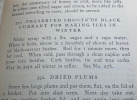The Russian Cook Book.
THE RUSSIAN COOK BOOK COMPILED & TRANSLATED BY Princess Alexandre Gagarine (The printers square lined device) LONDON: William Heinemann Ltd. With a green ornamental border.
FIRST BRITISH EDITION. 1924. 8vo. 1fep. Half Title. Verso publisher's note. Title page. [1] 1p Contents. [1] 1-247. [1] 2fep. Very clean text block. Orange cloth backed blind stamped boards. Gilt lettering on the spine. Original dust jacket very slightly rubbed on the top edge. Overall very clean and well preserved. An extremely scarce book with the fine dust jacket.
- The Russian Cook Book (translated into English by Princess Gagarine) originated in the kitchen of the sumptuous house of Madame Dragomirov, the wife of The Governor General of Kiev which was famed for its cuisine. At the request of her friends, she compiled the collection of her recipes and published it with great success in Russia. It was first published in the West in 1923, in New York by Alfred A. Knopf. Titled the 'The Borzoi Cook Book' it was translated by Princess Alexandre Gagarine. This copy is the first British edition of 1924, published in London by William Heinemann and re-titled 'The Russian Cook Book', also by Princess Alexandre Gagarine. This book of fine food is the product of a very privileged lifestyle and a large household budget. It is a direct result of Madame Draomirov's record of lavish entertaining. There is a recipe for 'Soup Puree of Game' consisting of 3lb Beef and 3 Birds, (either grouse, blackcock or partridges) 3/4 lb of Barley, 1 egg yolk, 1 cup of Cream and butter. Another recipe is for the French Sauce Bernaise served with Beef steaks. Further in the book are recipes for Roasts: Turkey stuffed with Chestnuts. Roast saddle of Roebuck. A roast Bustard along with all manner of game birds. Did the common peasant ever see such spreads in their whole life.? These recipes of all the great Russian dishes are from a time before the revolution of 1917. Princess Alexandre Gagarine the compiler and translator, had fled the revolution to America, but would herself have been a member of that Russian strata of high-level privilege. She did a prudent move by translating Madame Draomirov's successful Russian version of her cookbook. She probably needed the cash. Two very different, but popular cookery books of the time, certainly counterpoint the privileged richness of Gagarine's book. No 1 is 'A Gift to Young Housewives' 1861. A Russian cookbook written and compiled by Elena Ivanovna Molokhovets and usually referred to as "Molokhovets", rather than its long title. It was the most successful book of its kind in the 19th and early 20th-century in Russia. Molokhovets revised the book continually between 1861 and 1917, a period of time falling between the emancipation of the serfs and the Communist Revolution. The book was well known in Russian households during publication and for decades afterwards. It was republished in 2003. The 2nd influential cookery book after the October revolution of 1917 was 'The Book of Healthy and Tasty Food' by Anastas Mikoyan. What Elena Molokhovets is to nineteenth-century culinary history, Anastas Mikoyan, Stalin’s commissar for foreign trade is to the Soviet era. Mikoyan’s project was as welcome to Soviet housewives, to whom it is dedicated, as Molokhovet's book had been to their great-grandmothers. Containing more than 1,400 recipes, it sold more than 8 million copies and has never been out of print since it’s 1952 publication (it was first issued in 1939, but the war hindered further print editions) Many of the recipes in the Book, as it is lovingly referred to, begin with “open a tin of…” reflecting the ubiquity of tinned food, as well as the fact that many Soviet citizens were still in possession of only one burner on a communal apartment stove. Mikoyan's book’s recipes contain ingredients that can be counted on the fingers of one hand and only a few simple steps. It also contains useful information on nutrition, cooking methods, and even the etiquette of setting a proper table, reflecting the post-war trend of returning to family life. Whereas Mikoyan's book is a government sponsored production for the masses, the 416 recipes of great variety in Princess Alexandre Gagarine's cookery book are strongly biased and worded due to the French influence in the Royal Kitchens of St.Petersburg, where great chefs like Careme and Urbain Dubois spent some time. This would have a profound knock-on effect on the kitchens and dining tables of the pre-revolution elite classes, who were strongly influenced by all things Royal. When reading the recipes one thing that surprises, is the amazing and varied abundance available, of the fresh food from water, land and air. A fascinating insight into a cuisine that is not so well known outside of Russia, plus a lifestyle that disappeared for a long time till the growth of new Russian middle and upper classes and the oligarchs, with their wealth, helped to re-establish a similar level of demand and consumption. Indeed, an ironic democratic dynamic.






click on image to enlarge

Modern category
ref number:
11266